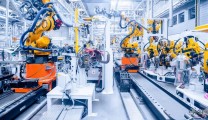What are the 7 wastes in manufacturing?
The 7 wastes in manufacturing include:
- Waste in transportation
- Waste of defective goods
- Unreasonable process
- Inventory
- redundant movement
- Wait
Solution to eliminate 7 wastes in production
Eliminate waste in transportation
Transportation waste is the loss, damage, or disruption that occurs when moving a product from the point of production to the point of consumption. This type of waste often comes from poor packaging, careless handling, inefficient supply chain management, or transportation issues, etc.

Waste in transportation
For example: A ceramic manufacturing company exports its products to foreign markets. During transportation, due to improper packaging, many ceramic items are broken when they reach the destination. This causes loss and waste of the company's goods.
Solution:
- Optimize packaging process: Use packaging materials such as bubble wrap, foam boxes and reinforce the corners of the box to protect the product from impact.
- Improve loading and unloading processes: Train employees in safe and efficient loading and unloading techniques, using support tools such as forklifts to minimize collisions.
- Use shipping tracking technology: Apply GPS tracking system and barcode to monitor the shipping process and status of goods.
- Improve management system: Establish strict transportation management process, periodically check and evaluate performance to quickly fix arising problems.
Eliminate waste from defective goods
Waste due to defects occurs when a product fails to meet quality standards, has a technical problem, resulting in the cost of repair, recycling or disposal. This can be due to errors in the manufacturing process, poor quality raw materials, or problems during inspection.

Waste from defective goods
For example, a phone manufacturing company discovers that some of its newly manufactured products have screen defects, causing them to be returned or repaired. This not only reduces profits but also affects the company's image with customers.
Solution:
- Strict production quality control: Implement quality control at each stage of production to detect defects early.
- Choose reliable suppliers: Cooperate with reputable suppliers to ensure raw materials meet quality standards.
- Root Cause Analysis and Continuous Improvement: Perform root cause analysis of errors to develop corrective actions and prevent recurrence.
- Apply smart technology: Use automation technologies to manage and monitor product quality.
Eliminate waste due to unreasonable processes
Process waste is inefficiency in work sequences and performance. This results in unnecessary waste of time, energy, and effort.

Waste due to unreasonable process
For example, in a production line, workers have to move the working conditions many times to perform production steps, wasting unnecessary time and effort.
Solution:
- Workflow Optimization: Evaluate and optimize workflow in production. Thereby reducing unnecessary steps, optimizing employee movement.
- Apply the 5S principle: Use the 5S principle to organize and arrange your workspace effectively.
- Create synchronization and coordination: Ensure synchronization between production stages to avoid unnecessary waiting and adjustments.
- Training and skills development: Train employees in the necessary skills and provide guidance to perform the job effectively.
Eliminate waste in inventory
This waste comes from storing more raw materials or finished products than needed. The buildup of inventory not only causes costs but also increases the risk of damage and loss.

Waste in inventory
For example, a shoe factory accumulates too much unsold product in inventory, resulting in high storage costs and the risk of damage due to exposure to the environment.
Solution:
- Optimize ordering and supply processes: Evaluate and optimize ordering processes to avoid over-ordering and minimize inventory holding time.
- Apply "Just-in-Time" (JIT) production method: Produce only the quantity needed and at the right time, minimizing unnecessary inventory.
- Strengthen quality management: Ensure quality from the production stage to avoid defective and substandard products.
- Optimize warehouse management: Use modern warehouse management software to monitor and evaluate warehouse management performance.
Eliminate waste from redundant movements
When mentioning the 7 wastes in production, we cannot ignore the redundant steps. This waste occurs when the product is manufactured more complex than the customer requires, including performing unnecessary steps or too many details that do not meet actual needs.

Waste from redundant movements
For example, a shoe factory has a habit of using complex decorative attachments on each product, while the customer only requests a simple design.
Solution:
- Design Review and Optimization: Examine designs to eliminate unnecessary details and optimize product specifications.
- Establish production standards: Define and apply clear standards to the production process to ensure products meet customer requirements.
- Apply Kaizen method: Use Kaizen method to continuously improve production process and eliminate unnecessary activities.
Eliminate waiting waste
The last name on the list of 7 wastes in manufacturing is waiting. This waste occurs when a product or production process is delayed while waiting for materials, equipment, information, or maintenance repairs.

Waste of waiting
For example, car production was delayed due to a shortage of raw materials from suppliers, resulting in long waiting times during assembly.
Solution:
- Supply Chain Management: Ensure efficient supply chain management, from demand forecasting to timely ordering and delivery of materials.
- Monitor and adjust production processes: Use real-time tracking systems to monitor production processes and detect problems early. Adjust production schedules to minimize waiting times.
- Periodic maintenance and repair: Carry out periodic maintenance and repair of equipment and machinery to ensure the stability of the production process and avoid unnecessary delays.












Replies to This Discussion